Financial Awareness Report: Analysis of Qupital Limited Financial Data
VerifiedAdded on 2020/10/05
|20
|6343
|375
Report
AI Summary
This report, prepared for Qupital Limited, examines the significance of financial information and financial awareness within the company. It addresses the needs, purposes, limitations, and stakeholders involved in financial reporting, providing an overview of financial information including income statements, balance sheets, and cash flow statements. The report identifies accounting arrangements, including single and joint arrangements, and discusses accounting conventions such as conservatism, full disclosure, consistency, and materiality. It also explores the influence of accounting frameworks and regulations on financial information, the uses of published financial information, and management accounting practices. Furthermore, the report comments on key items in financial commentary, analyzes trends in published accounting information, and provides recommendations for financial planning. The analysis considers various stakeholders like customers, employees, government, communities and investors.
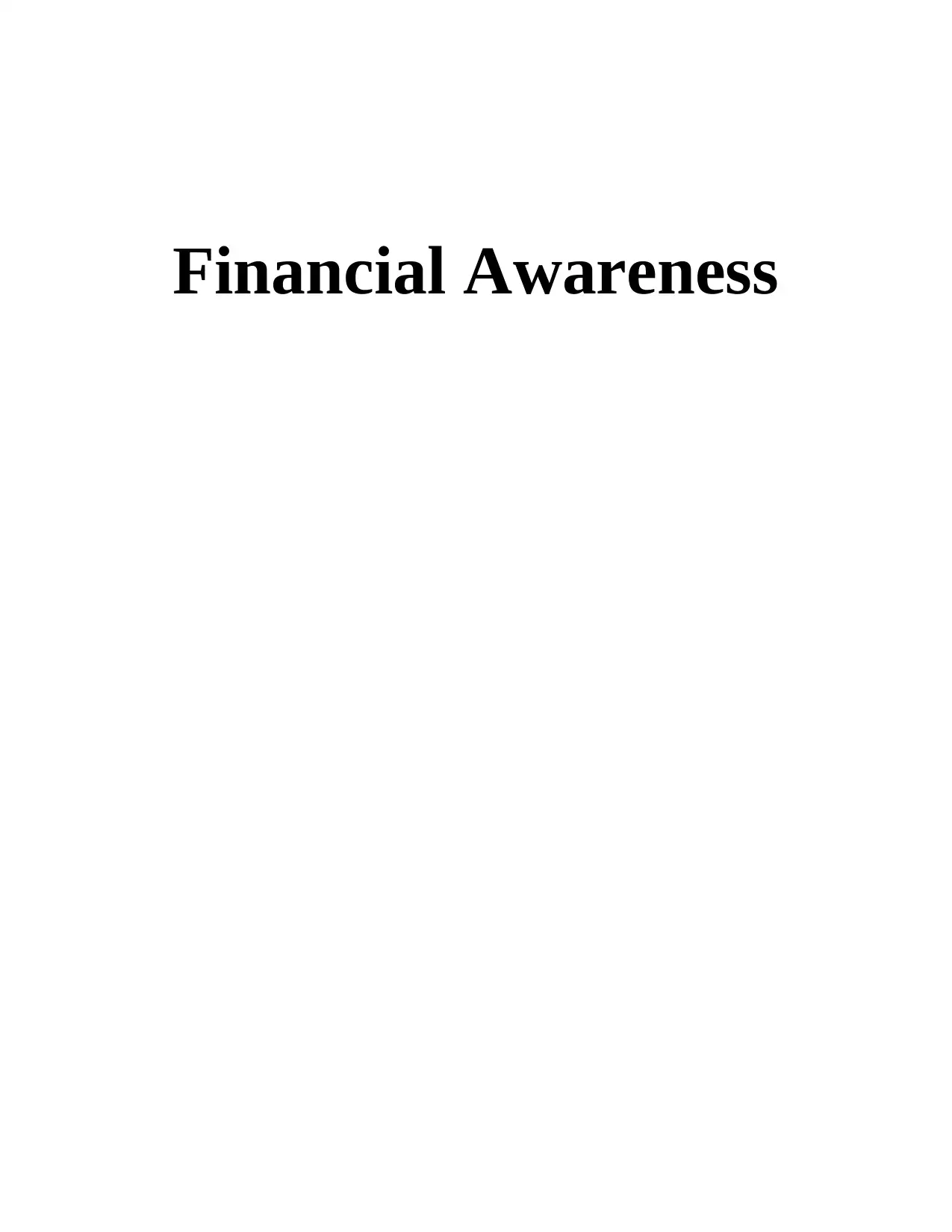
Financial Awareness
Paraphrase This Document
Need a fresh take? Get an instant paraphrase of this document with our AI Paraphraser

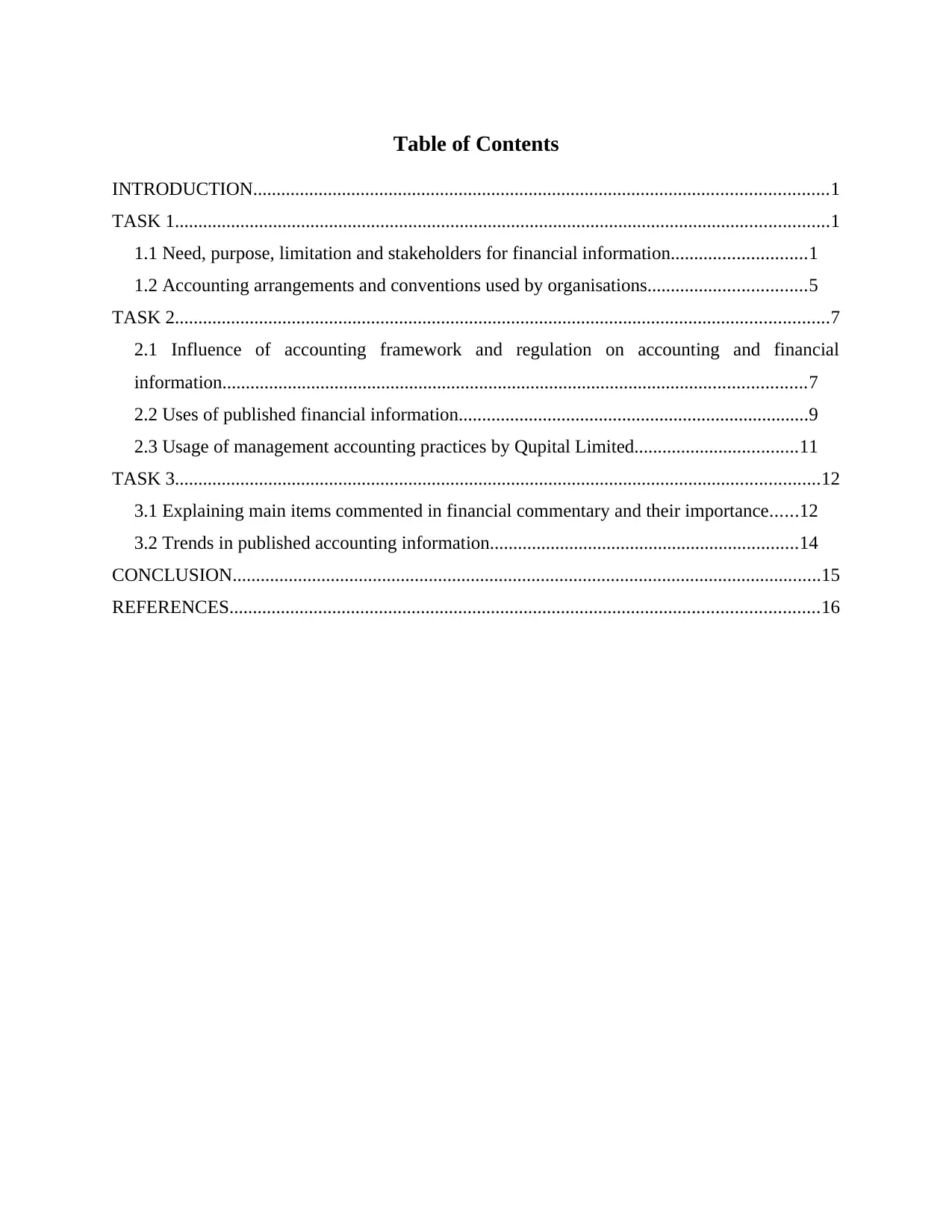
Table of Contents
INTRODUCTION...........................................................................................................................1
TASK 1............................................................................................................................................1
1.1 Need, purpose, limitation and stakeholders for financial information.............................1
1.2 Accounting arrangements and conventions used by organisations..................................5
TASK 2............................................................................................................................................7
2.1 Influence of accounting framework and regulation on accounting and financial
information.............................................................................................................................7
2.2 Uses of published financial information...........................................................................9
2.3 Usage of management accounting practices by Qupital Limited...................................11
TASK 3..........................................................................................................................................12
3.1 Explaining main items commented in financial commentary and their importance......12
3.2 Trends in published accounting information..................................................................14
CONCLUSION..............................................................................................................................15
REFERENCES..............................................................................................................................16
INTRODUCTION...........................................................................................................................1
TASK 1............................................................................................................................................1
1.1 Need, purpose, limitation and stakeholders for financial information.............................1
1.2 Accounting arrangements and conventions used by organisations..................................5
TASK 2............................................................................................................................................7
2.1 Influence of accounting framework and regulation on accounting and financial
information.............................................................................................................................7
2.2 Uses of published financial information...........................................................................9
2.3 Usage of management accounting practices by Qupital Limited...................................11
TASK 3..........................................................................................................................................12
3.1 Explaining main items commented in financial commentary and their importance......12
3.2 Trends in published accounting information..................................................................14
CONCLUSION..............................................................................................................................15
REFERENCES..............................................................................................................................16
⊘ This is a preview!⊘
Do you want full access?
Subscribe today to unlock all pages.

Trusted by 1+ million students worldwide
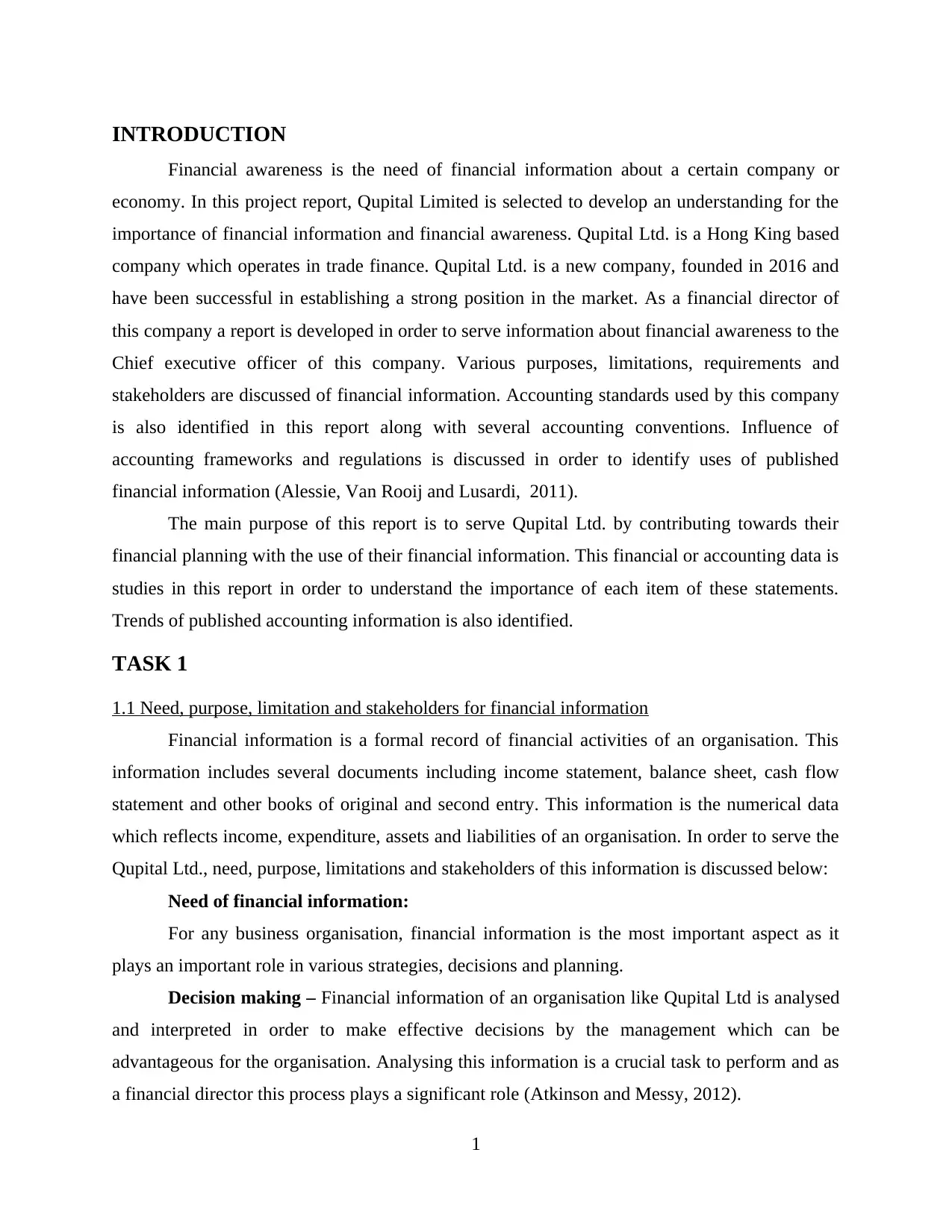
INTRODUCTION
Financial awareness is the need of financial information about a certain company or
economy. In this project report, Qupital Limited is selected to develop an understanding for the
importance of financial information and financial awareness. Qupital Ltd. is a Hong King based
company which operates in trade finance. Qupital Ltd. is a new company, founded in 2016 and
have been successful in establishing a strong position in the market. As a financial director of
this company a report is developed in order to serve information about financial awareness to the
Chief executive officer of this company. Various purposes, limitations, requirements and
stakeholders are discussed of financial information. Accounting standards used by this company
is also identified in this report along with several accounting conventions. Influence of
accounting frameworks and regulations is discussed in order to identify uses of published
financial information (Alessie, Van Rooij and Lusardi, 2011).
The main purpose of this report is to serve Qupital Ltd. by contributing towards their
financial planning with the use of their financial information. This financial or accounting data is
studies in this report in order to understand the importance of each item of these statements.
Trends of published accounting information is also identified.
TASK 1
1.1 Need, purpose, limitation and stakeholders for financial information
Financial information is a formal record of financial activities of an organisation. This
information includes several documents including income statement, balance sheet, cash flow
statement and other books of original and second entry. This information is the numerical data
which reflects income, expenditure, assets and liabilities of an organisation. In order to serve the
Qupital Ltd., need, purpose, limitations and stakeholders of this information is discussed below:
Need of financial information:
For any business organisation, financial information is the most important aspect as it
plays an important role in various strategies, decisions and planning.
Decision making – Financial information of an organisation like Qupital Ltd is analysed
and interpreted in order to make effective decisions by the management which can be
advantageous for the organisation. Analysing this information is a crucial task to perform and as
a financial director this process plays a significant role (Atkinson and Messy, 2012).
1
Financial awareness is the need of financial information about a certain company or
economy. In this project report, Qupital Limited is selected to develop an understanding for the
importance of financial information and financial awareness. Qupital Ltd. is a Hong King based
company which operates in trade finance. Qupital Ltd. is a new company, founded in 2016 and
have been successful in establishing a strong position in the market. As a financial director of
this company a report is developed in order to serve information about financial awareness to the
Chief executive officer of this company. Various purposes, limitations, requirements and
stakeholders are discussed of financial information. Accounting standards used by this company
is also identified in this report along with several accounting conventions. Influence of
accounting frameworks and regulations is discussed in order to identify uses of published
financial information (Alessie, Van Rooij and Lusardi, 2011).
The main purpose of this report is to serve Qupital Ltd. by contributing towards their
financial planning with the use of their financial information. This financial or accounting data is
studies in this report in order to understand the importance of each item of these statements.
Trends of published accounting information is also identified.
TASK 1
1.1 Need, purpose, limitation and stakeholders for financial information
Financial information is a formal record of financial activities of an organisation. This
information includes several documents including income statement, balance sheet, cash flow
statement and other books of original and second entry. This information is the numerical data
which reflects income, expenditure, assets and liabilities of an organisation. In order to serve the
Qupital Ltd., need, purpose, limitations and stakeholders of this information is discussed below:
Need of financial information:
For any business organisation, financial information is the most important aspect as it
plays an important role in various strategies, decisions and planning.
Decision making – Financial information of an organisation like Qupital Ltd is analysed
and interpreted in order to make effective decisions by the management which can be
advantageous for the organisation. Analysing this information is a crucial task to perform and as
a financial director this process plays a significant role (Atkinson and Messy, 2012).
1
Paraphrase This Document
Need a fresh take? Get an instant paraphrase of this document with our AI Paraphraser
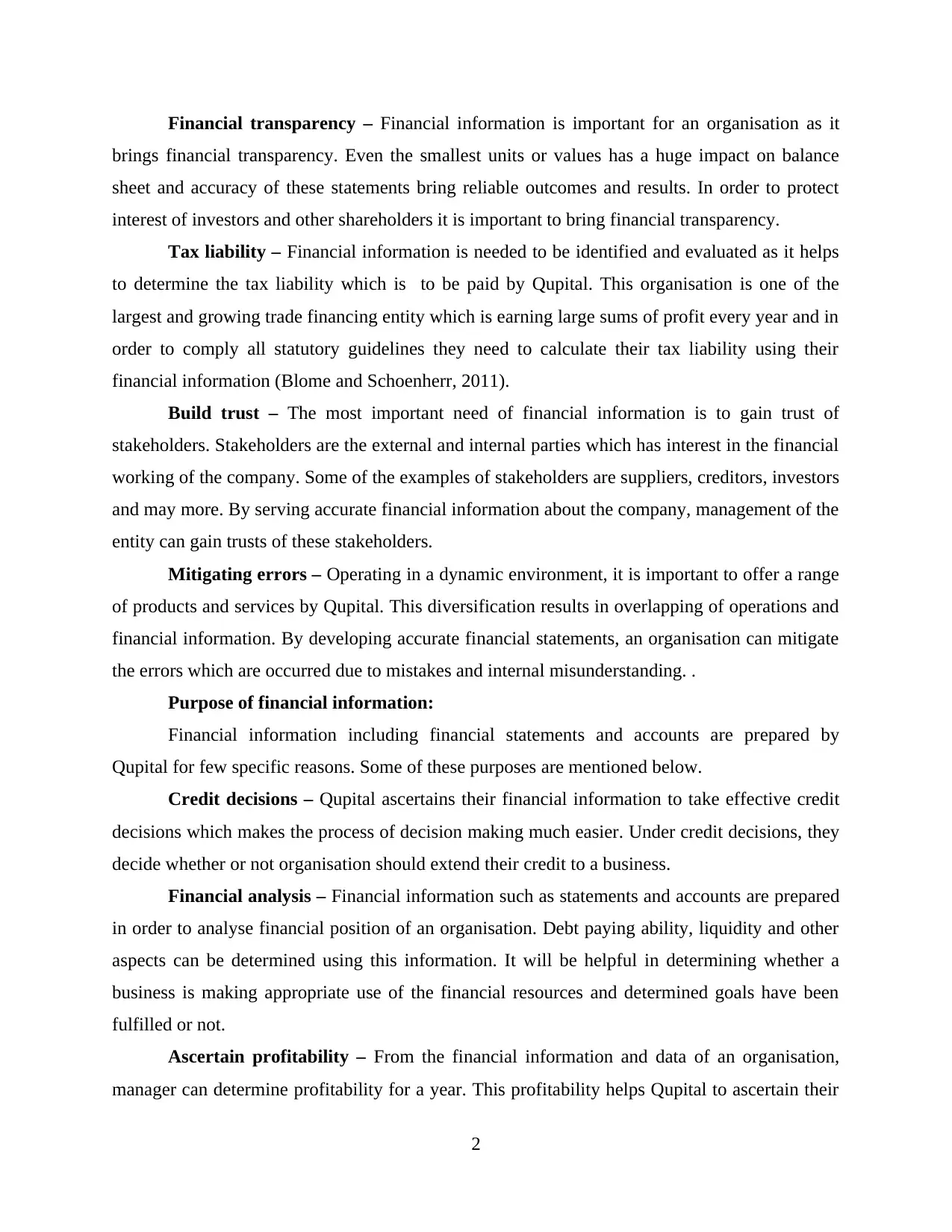
Financial transparency – Financial information is important for an organisation as it
brings financial transparency. Even the smallest units or values has a huge impact on balance
sheet and accuracy of these statements bring reliable outcomes and results. In order to protect
interest of investors and other shareholders it is important to bring financial transparency.
Tax liability – Financial information is needed to be identified and evaluated as it helps
to determine the tax liability which is to be paid by Qupital. This organisation is one of the
largest and growing trade financing entity which is earning large sums of profit every year and in
order to comply all statutory guidelines they need to calculate their tax liability using their
financial information (Blome and Schoenherr, 2011).
Build trust – The most important need of financial information is to gain trust of
stakeholders. Stakeholders are the external and internal parties which has interest in the financial
working of the company. Some of the examples of stakeholders are suppliers, creditors, investors
and may more. By serving accurate financial information about the company, management of the
entity can gain trusts of these stakeholders.
Mitigating errors – Operating in a dynamic environment, it is important to offer a range
of products and services by Qupital. This diversification results in overlapping of operations and
financial information. By developing accurate financial statements, an organisation can mitigate
the errors which are occurred due to mistakes and internal misunderstanding. .
Purpose of financial information:
Financial information including financial statements and accounts are prepared by
Qupital for few specific reasons. Some of these purposes are mentioned below.
Credit decisions – Qupital ascertains their financial information to take effective credit
decisions which makes the process of decision making much easier. Under credit decisions, they
decide whether or not organisation should extend their credit to a business.
Financial analysis – Financial information such as statements and accounts are prepared
in order to analyse financial position of an organisation. Debt paying ability, liquidity and other
aspects can be determined using this information. It will be helpful in determining whether a
business is making appropriate use of the financial resources and determined goals have been
fulfilled or not.
Ascertain profitability – From the financial information and data of an organisation,
manager can determine profitability for a year. This profitability helps Qupital to ascertain their
2
brings financial transparency. Even the smallest units or values has a huge impact on balance
sheet and accuracy of these statements bring reliable outcomes and results. In order to protect
interest of investors and other shareholders it is important to bring financial transparency.
Tax liability – Financial information is needed to be identified and evaluated as it helps
to determine the tax liability which is to be paid by Qupital. This organisation is one of the
largest and growing trade financing entity which is earning large sums of profit every year and in
order to comply all statutory guidelines they need to calculate their tax liability using their
financial information (Blome and Schoenherr, 2011).
Build trust – The most important need of financial information is to gain trust of
stakeholders. Stakeholders are the external and internal parties which has interest in the financial
working of the company. Some of the examples of stakeholders are suppliers, creditors, investors
and may more. By serving accurate financial information about the company, management of the
entity can gain trusts of these stakeholders.
Mitigating errors – Operating in a dynamic environment, it is important to offer a range
of products and services by Qupital. This diversification results in overlapping of operations and
financial information. By developing accurate financial statements, an organisation can mitigate
the errors which are occurred due to mistakes and internal misunderstanding. .
Purpose of financial information:
Financial information including financial statements and accounts are prepared by
Qupital for few specific reasons. Some of these purposes are mentioned below.
Credit decisions – Qupital ascertains their financial information to take effective credit
decisions which makes the process of decision making much easier. Under credit decisions, they
decide whether or not organisation should extend their credit to a business.
Financial analysis – Financial information such as statements and accounts are prepared
in order to analyse financial position of an organisation. Debt paying ability, liquidity and other
aspects can be determined using this information. It will be helpful in determining whether a
business is making appropriate use of the financial resources and determined goals have been
fulfilled or not.
Ascertain profitability – From the financial information and data of an organisation,
manager can determine profitability for a year. This profitability helps Qupital to ascertain their
2
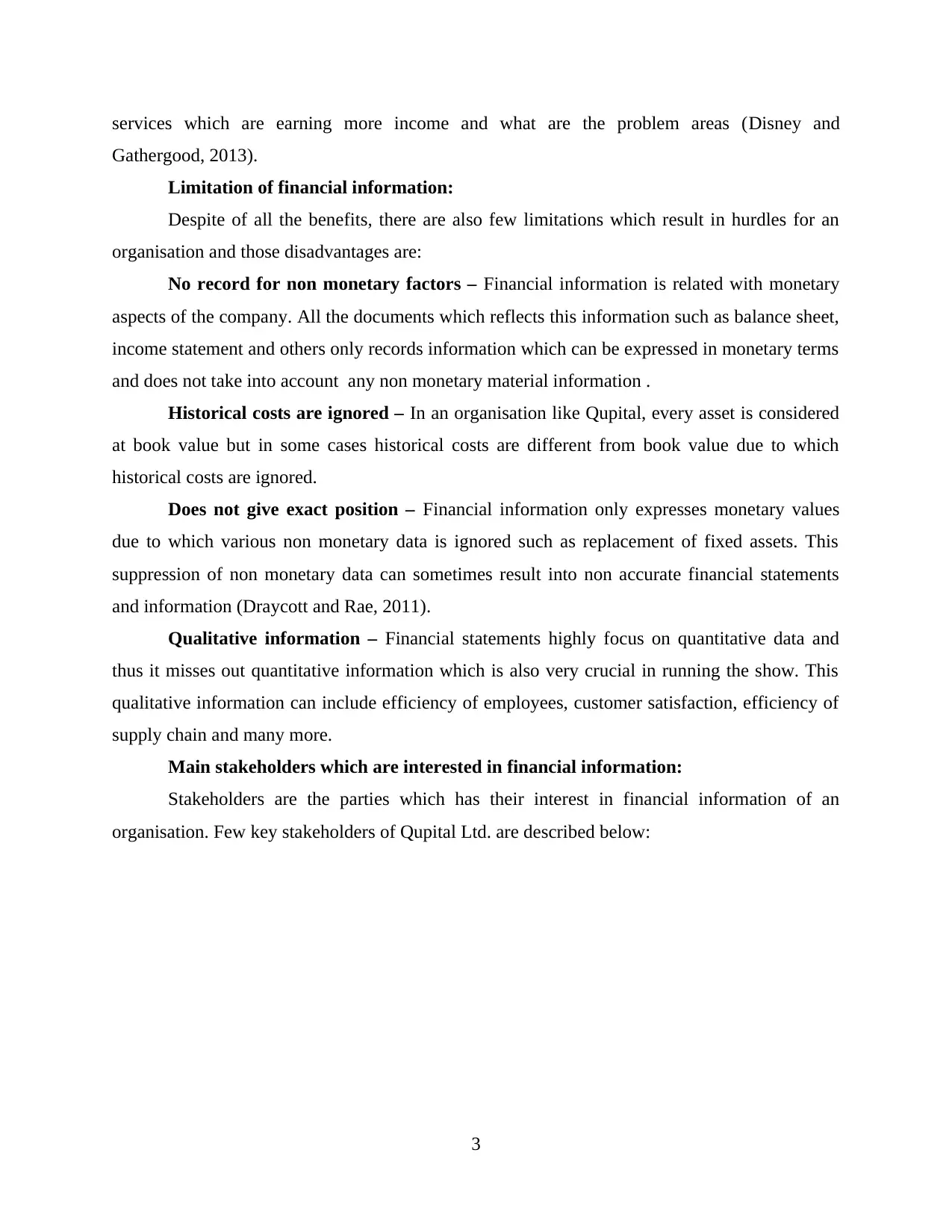
services which are earning more income and what are the problem areas (Disney and
Gathergood, 2013).
Limitation of financial information:
Despite of all the benefits, there are also few limitations which result in hurdles for an
organisation and those disadvantages are:
No record for non monetary factors – Financial information is related with monetary
aspects of the company. All the documents which reflects this information such as balance sheet,
income statement and others only records information which can be expressed in monetary terms
and does not take into account any non monetary material information .
Historical costs are ignored – In an organisation like Qupital, every asset is considered
at book value but in some cases historical costs are different from book value due to which
historical costs are ignored.
Does not give exact position – Financial information only expresses monetary values
due to which various non monetary data is ignored such as replacement of fixed assets. This
suppression of non monetary data can sometimes result into non accurate financial statements
and information (Draycott and Rae, 2011).
Qualitative information – Financial statements highly focus on quantitative data and
thus it misses out quantitative information which is also very crucial in running the show. This
qualitative information can include efficiency of employees, customer satisfaction, efficiency of
supply chain and many more.
Main stakeholders which are interested in financial information:
Stakeholders are the parties which has their interest in financial information of an
organisation. Few key stakeholders of Qupital Ltd. are described below:
3
Gathergood, 2013).
Limitation of financial information:
Despite of all the benefits, there are also few limitations which result in hurdles for an
organisation and those disadvantages are:
No record for non monetary factors – Financial information is related with monetary
aspects of the company. All the documents which reflects this information such as balance sheet,
income statement and others only records information which can be expressed in monetary terms
and does not take into account any non monetary material information .
Historical costs are ignored – In an organisation like Qupital, every asset is considered
at book value but in some cases historical costs are different from book value due to which
historical costs are ignored.
Does not give exact position – Financial information only expresses monetary values
due to which various non monetary data is ignored such as replacement of fixed assets. This
suppression of non monetary data can sometimes result into non accurate financial statements
and information (Draycott and Rae, 2011).
Qualitative information – Financial statements highly focus on quantitative data and
thus it misses out quantitative information which is also very crucial in running the show. This
qualitative information can include efficiency of employees, customer satisfaction, efficiency of
supply chain and many more.
Main stakeholders which are interested in financial information:
Stakeholders are the parties which has their interest in financial information of an
organisation. Few key stakeholders of Qupital Ltd. are described below:
3
⊘ This is a preview!⊘
Do you want full access?
Subscribe today to unlock all pages.

Trusted by 1+ million students worldwide
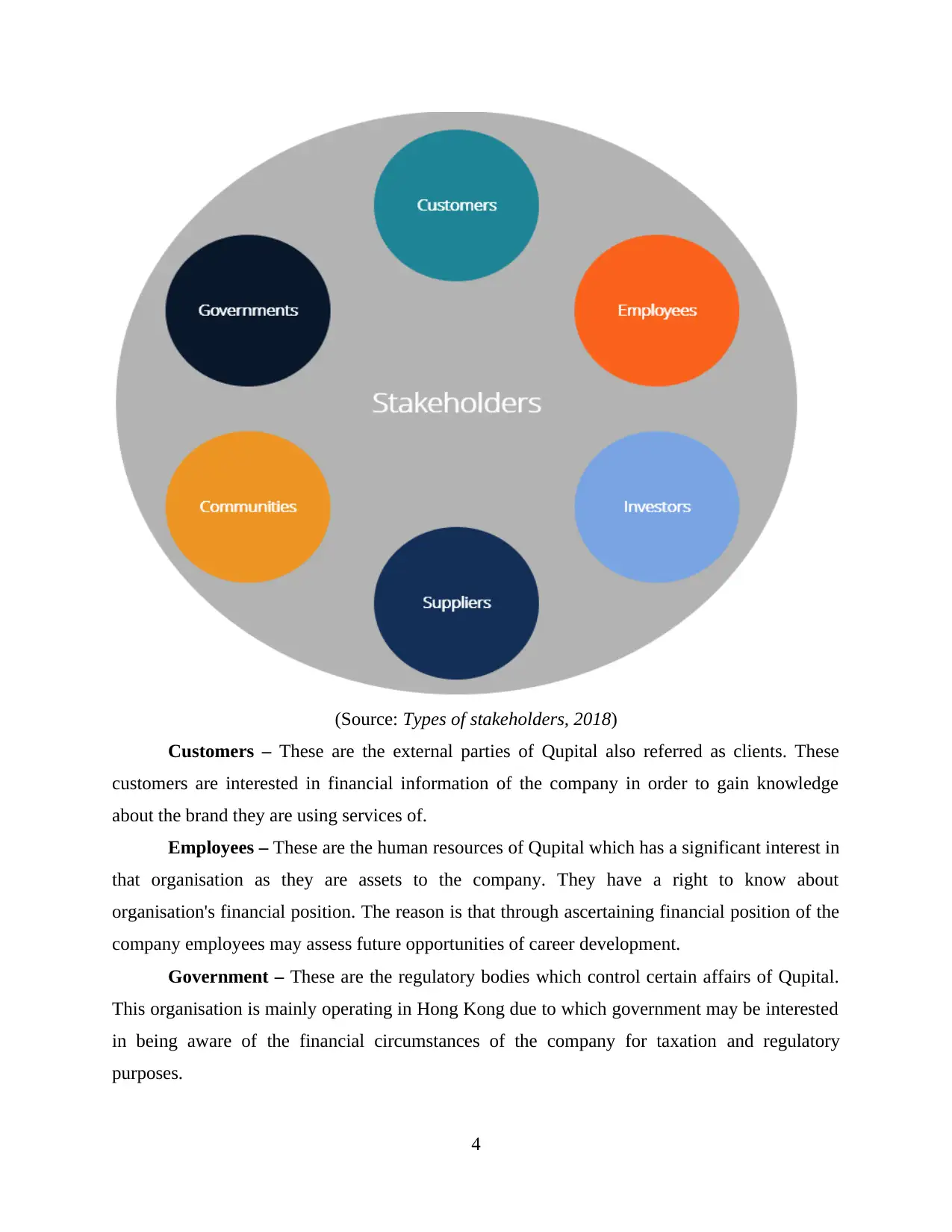
(Source: Types of stakeholders, 2018)
Customers – These are the external parties of Qupital also referred as clients. These
customers are interested in financial information of the company in order to gain knowledge
about the brand they are using services of.
Employees – These are the human resources of Qupital which has a significant interest in
that organisation as they are assets to the company. They have a right to know about
organisation's financial position. The reason is that through ascertaining financial position of the
company employees may assess future opportunities of career development.
Government – These are the regulatory bodies which control certain affairs of Qupital.
This organisation is mainly operating in Hong Kong due to which government may be interested
in being aware of the financial circumstances of the company for taxation and regulatory
purposes.
4
Customers – These are the external parties of Qupital also referred as clients. These
customers are interested in financial information of the company in order to gain knowledge
about the brand they are using services of.
Employees – These are the human resources of Qupital which has a significant interest in
that organisation as they are assets to the company. They have a right to know about
organisation's financial position. The reason is that through ascertaining financial position of the
company employees may assess future opportunities of career development.
Government – These are the regulatory bodies which control certain affairs of Qupital.
This organisation is mainly operating in Hong Kong due to which government may be interested
in being aware of the financial circumstances of the company for taxation and regulatory
purposes.
4
Paraphrase This Document
Need a fresh take? Get an instant paraphrase of this document with our AI Paraphraser
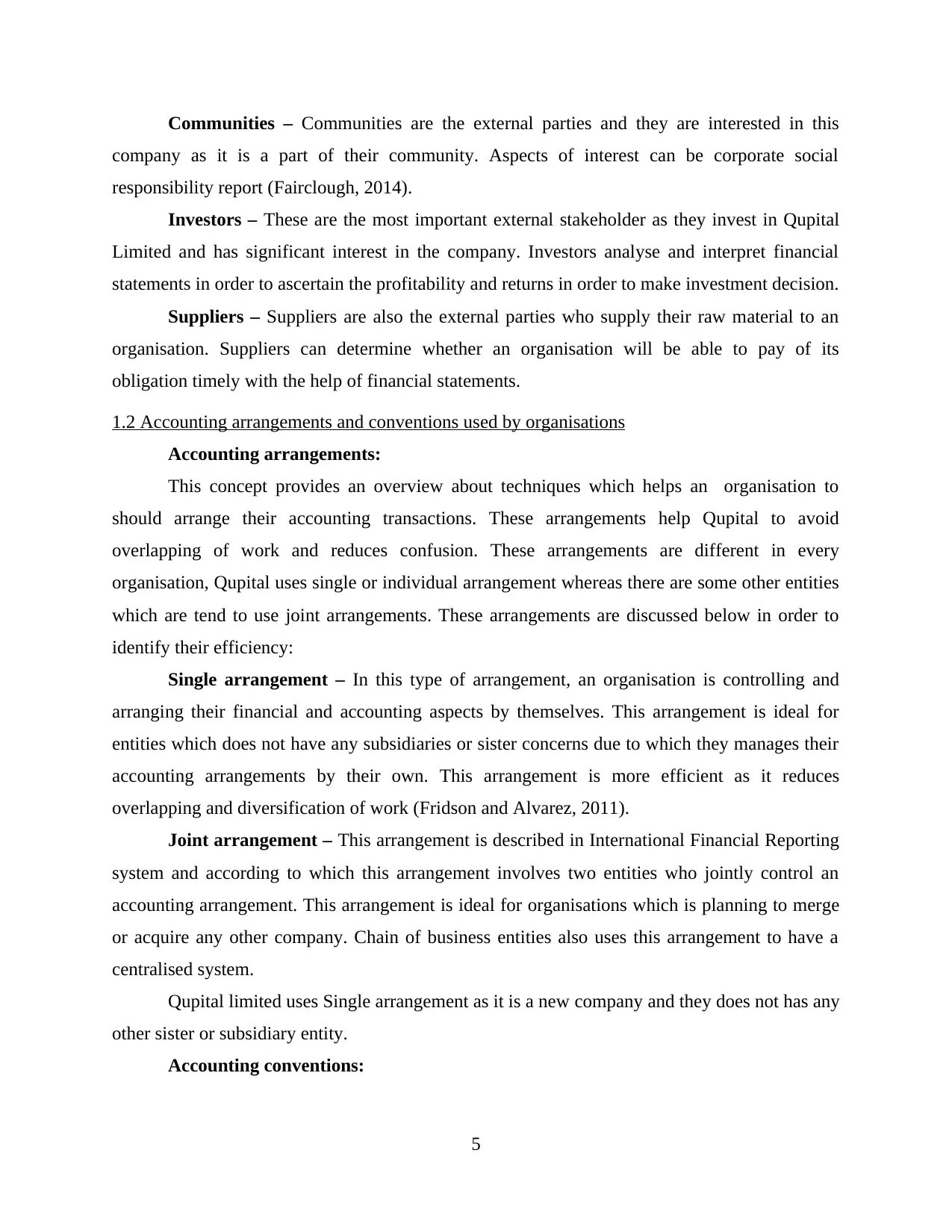
Communities – Communities are the external parties and they are interested in this
company as it is a part of their community. Aspects of interest can be corporate social
responsibility report (Fairclough, 2014).
Investors – These are the most important external stakeholder as they invest in Qupital
Limited and has significant interest in the company. Investors analyse and interpret financial
statements in order to ascertain the profitability and returns in order to make investment decision.
Suppliers – Suppliers are also the external parties who supply their raw material to an
organisation. Suppliers can determine whether an organisation will be able to pay of its
obligation timely with the help of financial statements.
1.2 Accounting arrangements and conventions used by organisations
Accounting arrangements:
This concept provides an overview about techniques which helps an organisation to
should arrange their accounting transactions. These arrangements help Qupital to avoid
overlapping of work and reduces confusion. These arrangements are different in every
organisation, Qupital uses single or individual arrangement whereas there are some other entities
which are tend to use joint arrangements. These arrangements are discussed below in order to
identify their efficiency:
Single arrangement – In this type of arrangement, an organisation is controlling and
arranging their financial and accounting aspects by themselves. This arrangement is ideal for
entities which does not have any subsidiaries or sister concerns due to which they manages their
accounting arrangements by their own. This arrangement is more efficient as it reduces
overlapping and diversification of work (Fridson and Alvarez, 2011).
Joint arrangement – This arrangement is described in International Financial Reporting
system and according to which this arrangement involves two entities who jointly control an
accounting arrangement. This arrangement is ideal for organisations which is planning to merge
or acquire any other company. Chain of business entities also uses this arrangement to have a
centralised system.
Qupital limited uses Single arrangement as it is a new company and they does not has any
other sister or subsidiary entity.
Accounting conventions:
5
company as it is a part of their community. Aspects of interest can be corporate social
responsibility report (Fairclough, 2014).
Investors – These are the most important external stakeholder as they invest in Qupital
Limited and has significant interest in the company. Investors analyse and interpret financial
statements in order to ascertain the profitability and returns in order to make investment decision.
Suppliers – Suppliers are also the external parties who supply their raw material to an
organisation. Suppliers can determine whether an organisation will be able to pay of its
obligation timely with the help of financial statements.
1.2 Accounting arrangements and conventions used by organisations
Accounting arrangements:
This concept provides an overview about techniques which helps an organisation to
should arrange their accounting transactions. These arrangements help Qupital to avoid
overlapping of work and reduces confusion. These arrangements are different in every
organisation, Qupital uses single or individual arrangement whereas there are some other entities
which are tend to use joint arrangements. These arrangements are discussed below in order to
identify their efficiency:
Single arrangement – In this type of arrangement, an organisation is controlling and
arranging their financial and accounting aspects by themselves. This arrangement is ideal for
entities which does not have any subsidiaries or sister concerns due to which they manages their
accounting arrangements by their own. This arrangement is more efficient as it reduces
overlapping and diversification of work (Fridson and Alvarez, 2011).
Joint arrangement – This arrangement is described in International Financial Reporting
system and according to which this arrangement involves two entities who jointly control an
accounting arrangement. This arrangement is ideal for organisations which is planning to merge
or acquire any other company. Chain of business entities also uses this arrangement to have a
centralised system.
Qupital limited uses Single arrangement as it is a new company and they does not has any
other sister or subsidiary entity.
Accounting conventions:
5
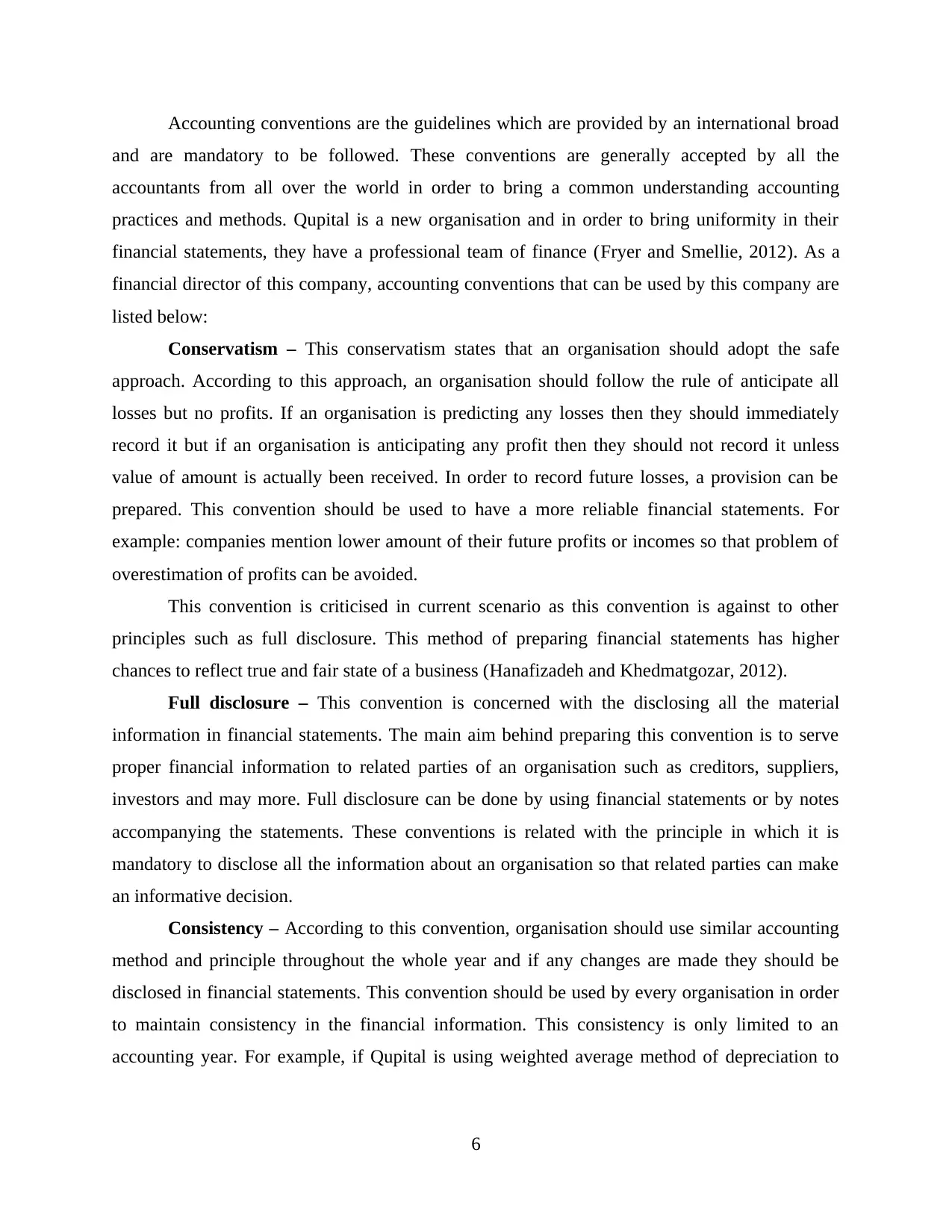
Accounting conventions are the guidelines which are provided by an international broad
and are mandatory to be followed. These conventions are generally accepted by all the
accountants from all over the world in order to bring a common understanding accounting
practices and methods. Qupital is a new organisation and in order to bring uniformity in their
financial statements, they have a professional team of finance (Fryer and Smellie, 2012). As a
financial director of this company, accounting conventions that can be used by this company are
listed below:
Conservatism – This conservatism states that an organisation should adopt the safe
approach. According to this approach, an organisation should follow the rule of anticipate all
losses but no profits. If an organisation is predicting any losses then they should immediately
record it but if an organisation is anticipating any profit then they should not record it unless
value of amount is actually been received. In order to record future losses, a provision can be
prepared. This convention should be used to have a more reliable financial statements. For
example: companies mention lower amount of their future profits or incomes so that problem of
overestimation of profits can be avoided.
This convention is criticised in current scenario as this convention is against to other
principles such as full disclosure. This method of preparing financial statements has higher
chances to reflect true and fair state of a business (Hanafizadeh and Khedmatgozar, 2012).
Full disclosure – This convention is concerned with the disclosing all the material
information in financial statements. The main aim behind preparing this convention is to serve
proper financial information to related parties of an organisation such as creditors, suppliers,
investors and may more. Full disclosure can be done by using financial statements or by notes
accompanying the statements. These conventions is related with the principle in which it is
mandatory to disclose all the information about an organisation so that related parties can make
an informative decision.
Consistency – According to this convention, organisation should use similar accounting
method and principle throughout the whole year and if any changes are made they should be
disclosed in financial statements. This convention should be used by every organisation in order
to maintain consistency in the financial information. This consistency is only limited to an
accounting year. For example, if Qupital is using weighted average method of depreciation to
6
and are mandatory to be followed. These conventions are generally accepted by all the
accountants from all over the world in order to bring a common understanding accounting
practices and methods. Qupital is a new organisation and in order to bring uniformity in their
financial statements, they have a professional team of finance (Fryer and Smellie, 2012). As a
financial director of this company, accounting conventions that can be used by this company are
listed below:
Conservatism – This conservatism states that an organisation should adopt the safe
approach. According to this approach, an organisation should follow the rule of anticipate all
losses but no profits. If an organisation is predicting any losses then they should immediately
record it but if an organisation is anticipating any profit then they should not record it unless
value of amount is actually been received. In order to record future losses, a provision can be
prepared. This convention should be used to have a more reliable financial statements. For
example: companies mention lower amount of their future profits or incomes so that problem of
overestimation of profits can be avoided.
This convention is criticised in current scenario as this convention is against to other
principles such as full disclosure. This method of preparing financial statements has higher
chances to reflect true and fair state of a business (Hanafizadeh and Khedmatgozar, 2012).
Full disclosure – This convention is concerned with the disclosing all the material
information in financial statements. The main aim behind preparing this convention is to serve
proper financial information to related parties of an organisation such as creditors, suppliers,
investors and may more. Full disclosure can be done by using financial statements or by notes
accompanying the statements. These conventions is related with the principle in which it is
mandatory to disclose all the information about an organisation so that related parties can make
an informative decision.
Consistency – According to this convention, organisation should use similar accounting
method and principle throughout the whole year and if any changes are made they should be
disclosed in financial statements. This convention should be used by every organisation in order
to maintain consistency in the financial information. This consistency is only limited to an
accounting year. For example, if Qupital is using weighted average method of depreciation to
6
⊘ This is a preview!⊘
Do you want full access?
Subscribe today to unlock all pages.

Trusted by 1+ million students worldwide
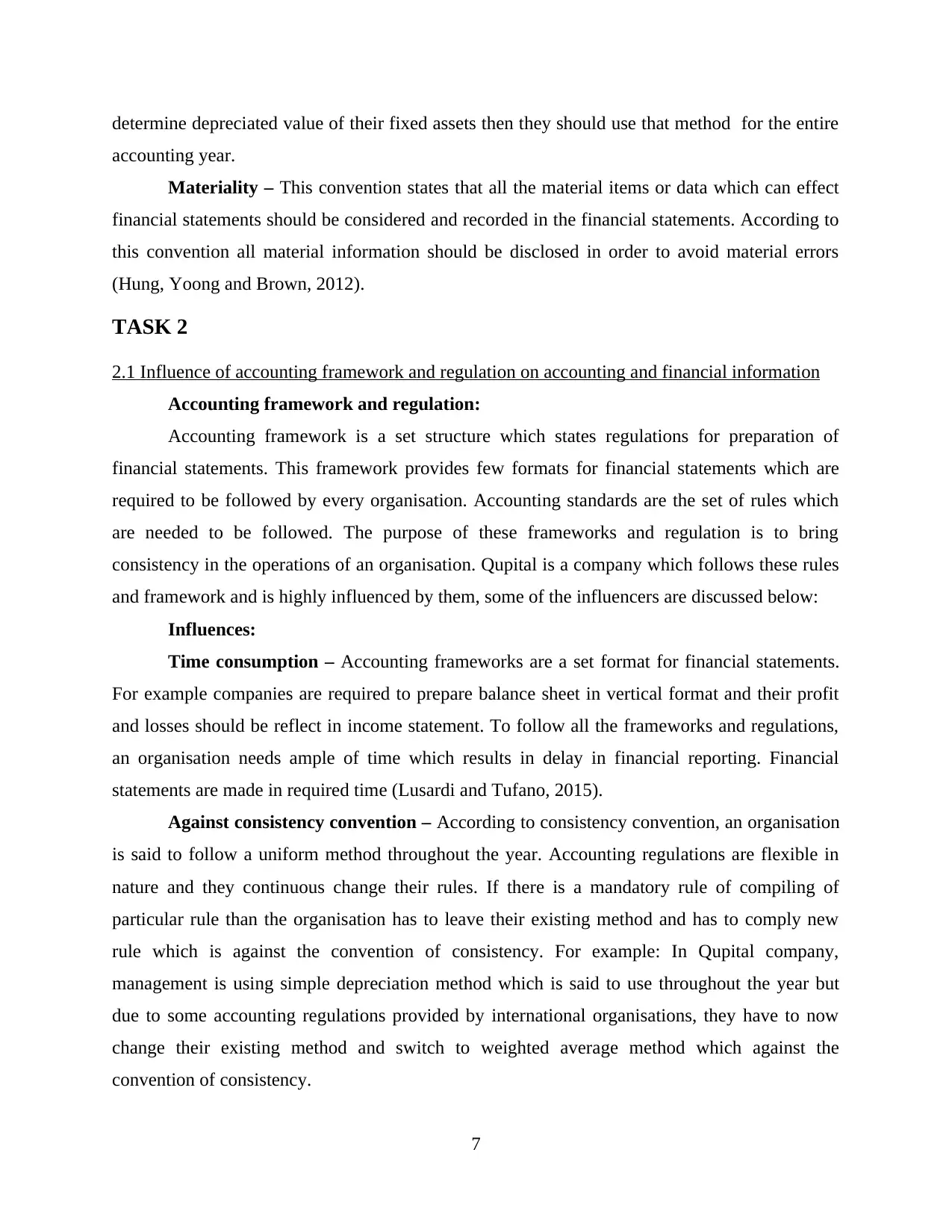
determine depreciated value of their fixed assets then they should use that method for the entire
accounting year.
Materiality – This convention states that all the material items or data which can effect
financial statements should be considered and recorded in the financial statements. According to
this convention all material information should be disclosed in order to avoid material errors
(Hung, Yoong and Brown, 2012).
TASK 2
2.1 Influence of accounting framework and regulation on accounting and financial information
Accounting framework and regulation:
Accounting framework is a set structure which states regulations for preparation of
financial statements. This framework provides few formats for financial statements which are
required to be followed by every organisation. Accounting standards are the set of rules which
are needed to be followed. The purpose of these frameworks and regulation is to bring
consistency in the operations of an organisation. Qupital is a company which follows these rules
and framework and is highly influenced by them, some of the influencers are discussed below:
Influences:
Time consumption – Accounting frameworks are a set format for financial statements.
For example companies are required to prepare balance sheet in vertical format and their profit
and losses should be reflect in income statement. To follow all the frameworks and regulations,
an organisation needs ample of time which results in delay in financial reporting. Financial
statements are made in required time (Lusardi and Tufano, 2015).
Against consistency convention – According to consistency convention, an organisation
is said to follow a uniform method throughout the year. Accounting regulations are flexible in
nature and they continuous change their rules. If there is a mandatory rule of compiling of
particular rule than the organisation has to leave their existing method and has to comply new
rule which is against the convention of consistency. For example: In Qupital company,
management is using simple depreciation method which is said to use throughout the year but
due to some accounting regulations provided by international organisations, they have to now
change their existing method and switch to weighted average method which against the
convention of consistency.
7
accounting year.
Materiality – This convention states that all the material items or data which can effect
financial statements should be considered and recorded in the financial statements. According to
this convention all material information should be disclosed in order to avoid material errors
(Hung, Yoong and Brown, 2012).
TASK 2
2.1 Influence of accounting framework and regulation on accounting and financial information
Accounting framework and regulation:
Accounting framework is a set structure which states regulations for preparation of
financial statements. This framework provides few formats for financial statements which are
required to be followed by every organisation. Accounting standards are the set of rules which
are needed to be followed. The purpose of these frameworks and regulation is to bring
consistency in the operations of an organisation. Qupital is a company which follows these rules
and framework and is highly influenced by them, some of the influencers are discussed below:
Influences:
Time consumption – Accounting frameworks are a set format for financial statements.
For example companies are required to prepare balance sheet in vertical format and their profit
and losses should be reflect in income statement. To follow all the frameworks and regulations,
an organisation needs ample of time which results in delay in financial reporting. Financial
statements are made in required time (Lusardi and Tufano, 2015).
Against consistency convention – According to consistency convention, an organisation
is said to follow a uniform method throughout the year. Accounting regulations are flexible in
nature and they continuous change their rules. If there is a mandatory rule of compiling of
particular rule than the organisation has to leave their existing method and has to comply new
rule which is against the convention of consistency. For example: In Qupital company,
management is using simple depreciation method which is said to use throughout the year but
due to some accounting regulations provided by international organisations, they have to now
change their existing method and switch to weighted average method which against the
convention of consistency.
7
Paraphrase This Document
Need a fresh take? Get an instant paraphrase of this document with our AI Paraphraser
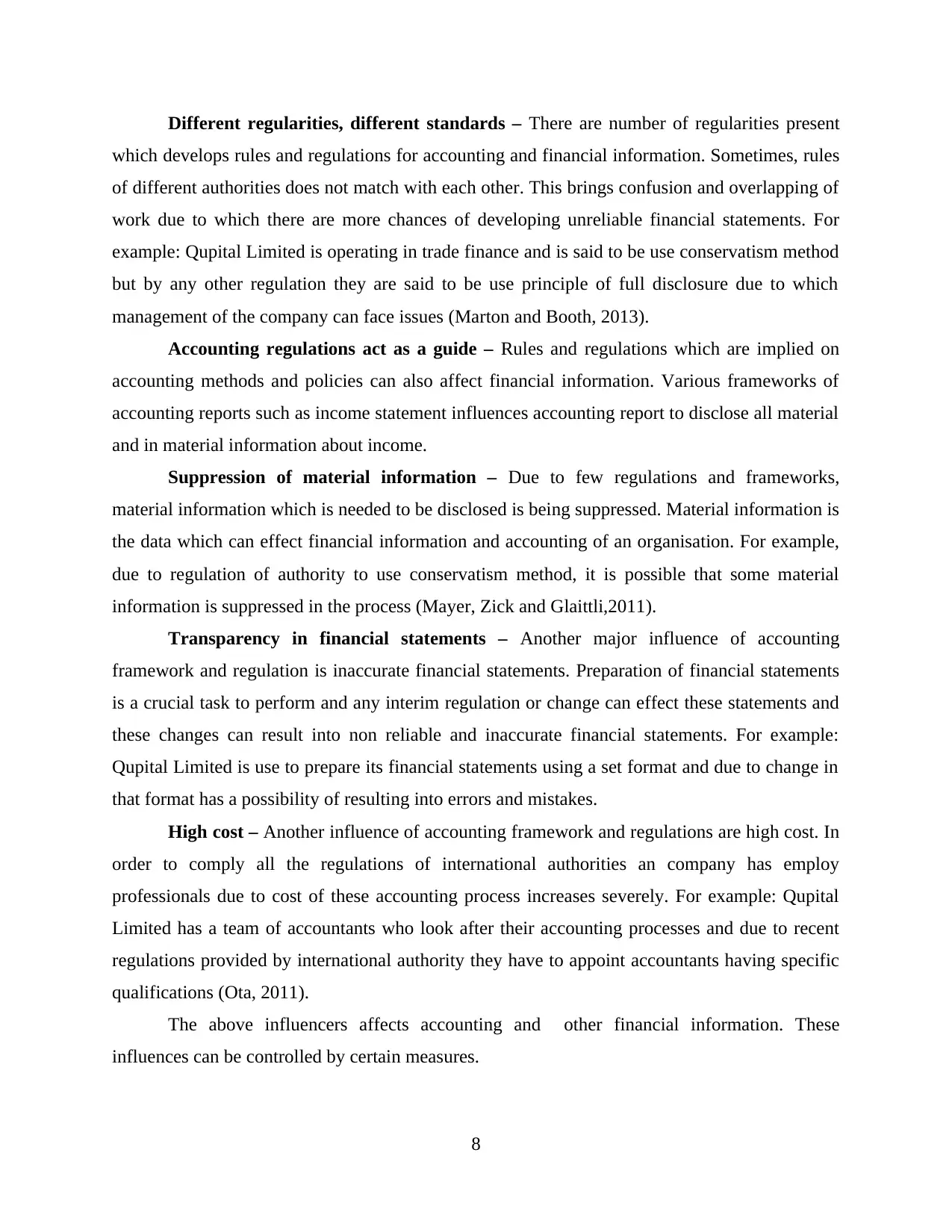
Different regularities, different standards – There are number of regularities present
which develops rules and regulations for accounting and financial information. Sometimes, rules
of different authorities does not match with each other. This brings confusion and overlapping of
work due to which there are more chances of developing unreliable financial statements. For
example: Qupital Limited is operating in trade finance and is said to be use conservatism method
but by any other regulation they are said to be use principle of full disclosure due to which
management of the company can face issues (Marton and Booth, 2013).
Accounting regulations act as a guide – Rules and regulations which are implied on
accounting methods and policies can also affect financial information. Various frameworks of
accounting reports such as income statement influences accounting report to disclose all material
and in material information about income.
Suppression of material information – Due to few regulations and frameworks,
material information which is needed to be disclosed is being suppressed. Material information is
the data which can effect financial information and accounting of an organisation. For example,
due to regulation of authority to use conservatism method, it is possible that some material
information is suppressed in the process (Mayer, Zick and Glaittli,2011).
Transparency in financial statements – Another major influence of accounting
framework and regulation is inaccurate financial statements. Preparation of financial statements
is a crucial task to perform and any interim regulation or change can effect these statements and
these changes can result into non reliable and inaccurate financial statements. For example:
Qupital Limited is use to prepare its financial statements using a set format and due to change in
that format has a possibility of resulting into errors and mistakes.
High cost – Another influence of accounting framework and regulations are high cost. In
order to comply all the regulations of international authorities an company has employ
professionals due to cost of these accounting process increases severely. For example: Qupital
Limited has a team of accountants who look after their accounting processes and due to recent
regulations provided by international authority they have to appoint accountants having specific
qualifications (Ota, 2011).
The above influencers affects accounting and other financial information. These
influences can be controlled by certain measures.
8
which develops rules and regulations for accounting and financial information. Sometimes, rules
of different authorities does not match with each other. This brings confusion and overlapping of
work due to which there are more chances of developing unreliable financial statements. For
example: Qupital Limited is operating in trade finance and is said to be use conservatism method
but by any other regulation they are said to be use principle of full disclosure due to which
management of the company can face issues (Marton and Booth, 2013).
Accounting regulations act as a guide – Rules and regulations which are implied on
accounting methods and policies can also affect financial information. Various frameworks of
accounting reports such as income statement influences accounting report to disclose all material
and in material information about income.
Suppression of material information – Due to few regulations and frameworks,
material information which is needed to be disclosed is being suppressed. Material information is
the data which can effect financial information and accounting of an organisation. For example,
due to regulation of authority to use conservatism method, it is possible that some material
information is suppressed in the process (Mayer, Zick and Glaittli,2011).
Transparency in financial statements – Another major influence of accounting
framework and regulation is inaccurate financial statements. Preparation of financial statements
is a crucial task to perform and any interim regulation or change can effect these statements and
these changes can result into non reliable and inaccurate financial statements. For example:
Qupital Limited is use to prepare its financial statements using a set format and due to change in
that format has a possibility of resulting into errors and mistakes.
High cost – Another influence of accounting framework and regulations are high cost. In
order to comply all the regulations of international authorities an company has employ
professionals due to cost of these accounting process increases severely. For example: Qupital
Limited has a team of accountants who look after their accounting processes and due to recent
regulations provided by international authority they have to appoint accountants having specific
qualifications (Ota, 2011).
The above influencers affects accounting and other financial information. These
influences can be controlled by certain measures.
8
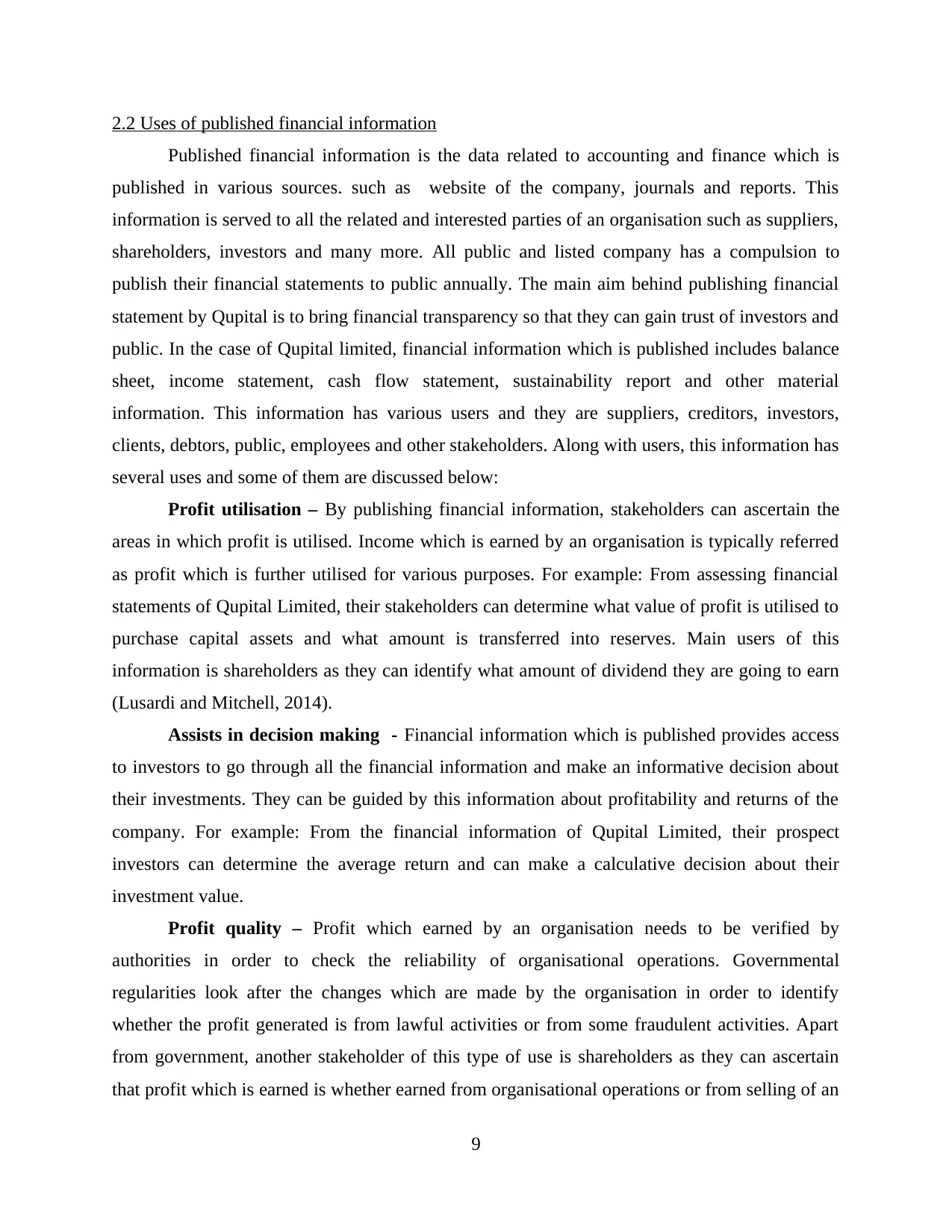
2.2 Uses of published financial information
Published financial information is the data related to accounting and finance which is
published in various sources. such as website of the company, journals and reports. This
information is served to all the related and interested parties of an organisation such as suppliers,
shareholders, investors and many more. All public and listed company has a compulsion to
publish their financial statements to public annually. The main aim behind publishing financial
statement by Qupital is to bring financial transparency so that they can gain trust of investors and
public. In the case of Qupital limited, financial information which is published includes balance
sheet, income statement, cash flow statement, sustainability report and other material
information. This information has various users and they are suppliers, creditors, investors,
clients, debtors, public, employees and other stakeholders. Along with users, this information has
several uses and some of them are discussed below:
Profit utilisation – By publishing financial information, stakeholders can ascertain the
areas in which profit is utilised. Income which is earned by an organisation is typically referred
as profit which is further utilised for various purposes. For example: From assessing financial
statements of Qupital Limited, their stakeholders can determine what value of profit is utilised to
purchase capital assets and what amount is transferred into reserves. Main users of this
information is shareholders as they can identify what amount of dividend they are going to earn
(Lusardi and Mitchell, 2014).
Assists in decision making - Financial information which is published provides access
to investors to go through all the financial information and make an informative decision about
their investments. They can be guided by this information about profitability and returns of the
company. For example: From the financial information of Qupital Limited, their prospect
investors can determine the average return and can make a calculative decision about their
investment value.
Profit quality – Profit which earned by an organisation needs to be verified by
authorities in order to check the reliability of organisational operations. Governmental
regularities look after the changes which are made by the organisation in order to identify
whether the profit generated is from lawful activities or from some fraudulent activities. Apart
from government, another stakeholder of this type of use is shareholders as they can ascertain
that profit which is earned is whether earned from organisational operations or from selling of an
9
Published financial information is the data related to accounting and finance which is
published in various sources. such as website of the company, journals and reports. This
information is served to all the related and interested parties of an organisation such as suppliers,
shareholders, investors and many more. All public and listed company has a compulsion to
publish their financial statements to public annually. The main aim behind publishing financial
statement by Qupital is to bring financial transparency so that they can gain trust of investors and
public. In the case of Qupital limited, financial information which is published includes balance
sheet, income statement, cash flow statement, sustainability report and other material
information. This information has various users and they are suppliers, creditors, investors,
clients, debtors, public, employees and other stakeholders. Along with users, this information has
several uses and some of them are discussed below:
Profit utilisation – By publishing financial information, stakeholders can ascertain the
areas in which profit is utilised. Income which is earned by an organisation is typically referred
as profit which is further utilised for various purposes. For example: From assessing financial
statements of Qupital Limited, their stakeholders can determine what value of profit is utilised to
purchase capital assets and what amount is transferred into reserves. Main users of this
information is shareholders as they can identify what amount of dividend they are going to earn
(Lusardi and Mitchell, 2014).
Assists in decision making - Financial information which is published provides access
to investors to go through all the financial information and make an informative decision about
their investments. They can be guided by this information about profitability and returns of the
company. For example: From the financial information of Qupital Limited, their prospect
investors can determine the average return and can make a calculative decision about their
investment value.
Profit quality – Profit which earned by an organisation needs to be verified by
authorities in order to check the reliability of organisational operations. Governmental
regularities look after the changes which are made by the organisation in order to identify
whether the profit generated is from lawful activities or from some fraudulent activities. Apart
from government, another stakeholder of this type of use is shareholders as they can ascertain
that profit which is earned is whether earned from organisational operations or from selling of an
9
⊘ This is a preview!⊘
Do you want full access?
Subscribe today to unlock all pages.

Trusted by 1+ million students worldwide
1 out of 20
Related Documents
Your All-in-One AI-Powered Toolkit for Academic Success.
+13062052269
info@desklib.com
Available 24*7 on WhatsApp / Email
![[object Object]](/_next/static/media/star-bottom.7253800d.svg)
Unlock your academic potential
Copyright © 2020–2025 A2Z Services. All Rights Reserved. Developed and managed by ZUCOL.




